Cool Science Experiments Headquarters
Making Science Fun, Easy to Teach and Exciting to Learn!
Science Experiments

Egg in a Bottle Science Experiment
Can eggs move by themselves? Maybe not, but with the help of air pressure, they can be pushed into a glass bottle without being touched!
In this experiment, your young scientists will learn about density and air pressure. And when you watch our demonstration video, you’ll see that although things didn’t go exactly as we expected, this experiment is always fun and educational. Printable instructions and a materials list are included.
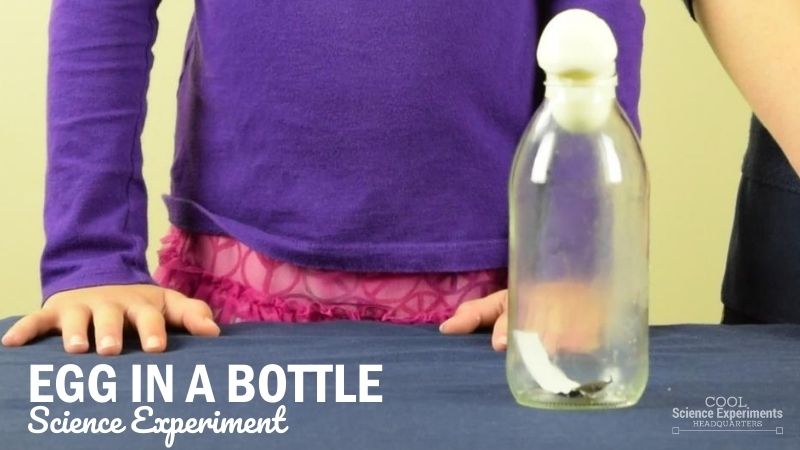
JUMP TO SECTION: Instructions | Video Tutorial | How it Works
Supplies Needed
- Hard-Boiled Egg (shell removed)
- Glass Bottle
- Thick Piece of Paper
- Match or Lighter
Safety Note: Because the experiment involves fire, adult supervision is required.
Egg in a Bottle Science Lab Kit – Only $5
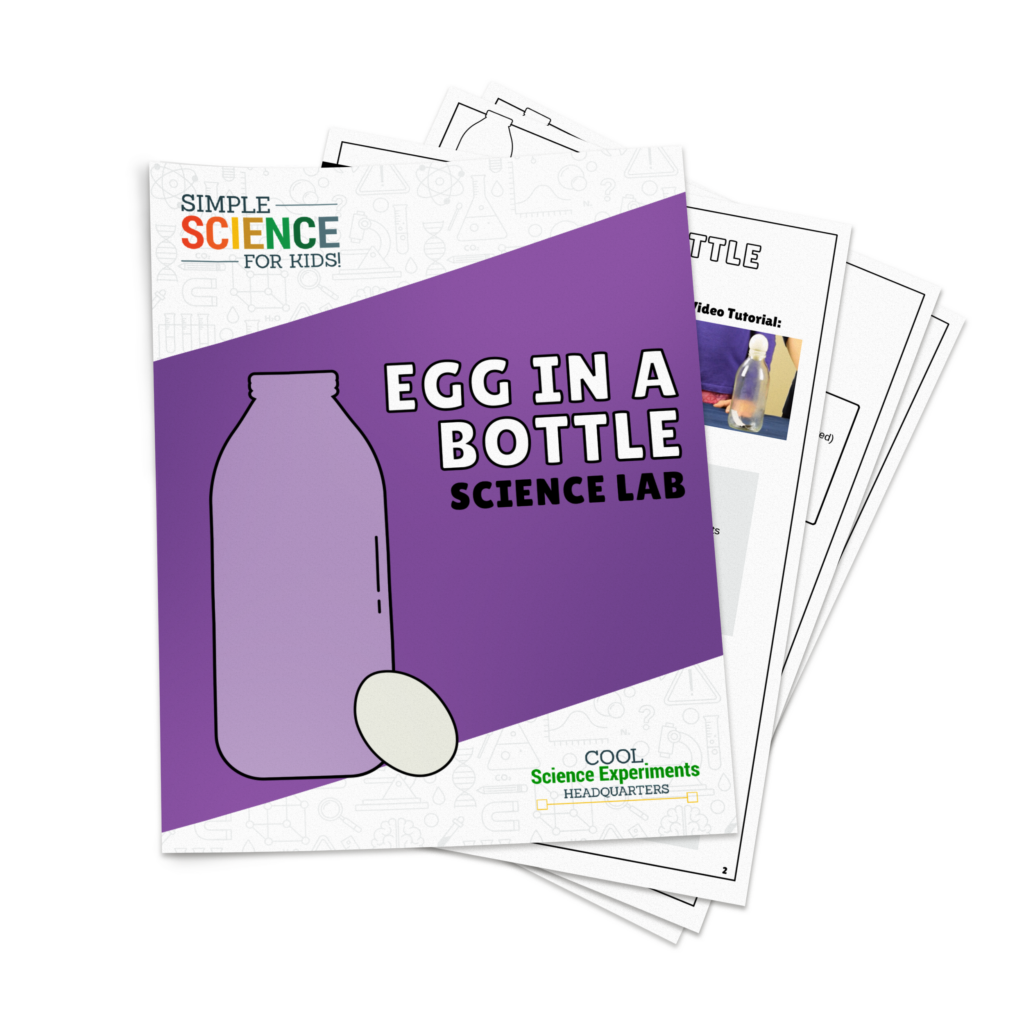
Use our easy Egg in a Bottle Science Lab Kit to grab your students’ attention without the stress of planning!
It’s everything you need to make science easy for teachers and fun for students — using inexpensive materials you probably already have in your storage closet!
Egg in a Bottle Science Experiment Instructions
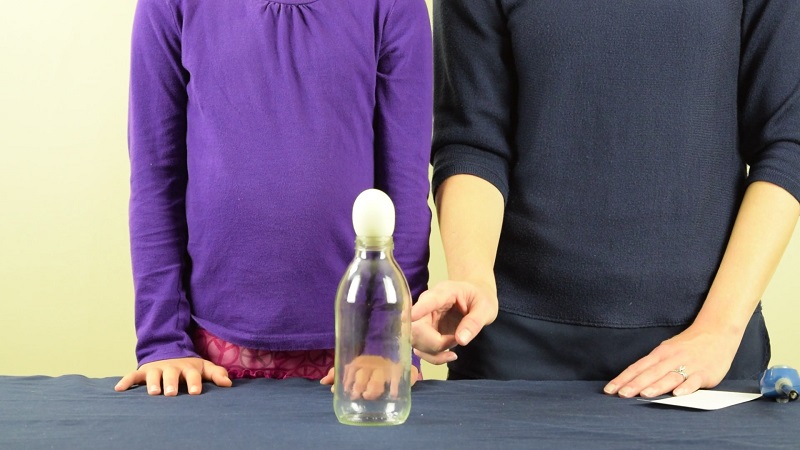
Step 1 – Remove the shell from the hard-boiled egg and place it on the mouth of the jar. Take a moment to make some observations. Why doesn’t the egg fit into the jar? Do you think it is possible to put the egg inside the jar? Do you think it is possible for the egg to move into the jar without touching it?
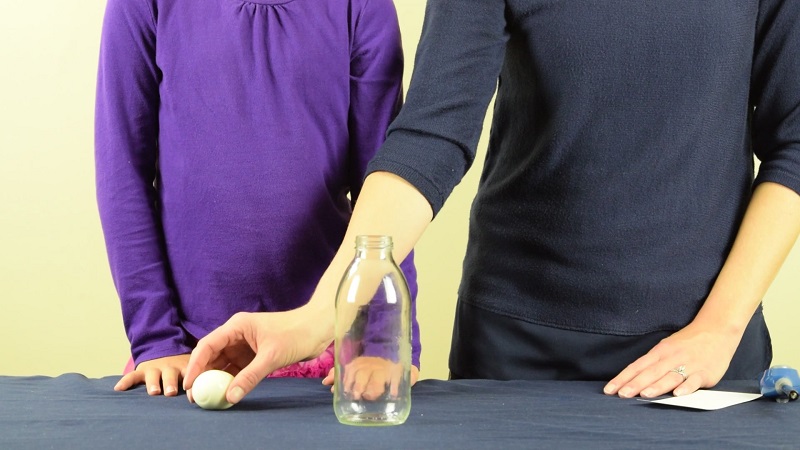
Step 2 – Remove the egg from the jar and set it on the table nearby. Make sure that you place it within reach because you’ll need to move quickly once it’s time to place the egg on the bottle again.
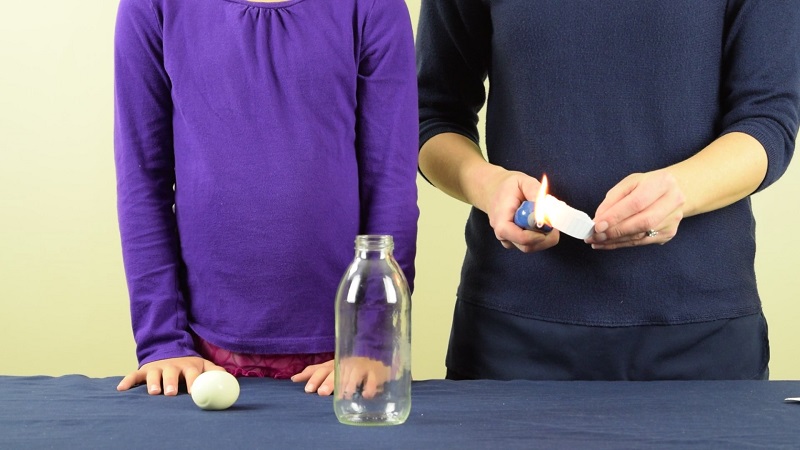
Step 2 – Get your strip of thick paper ready. Note that using thick paper is important because you need something that won’t burn too quickly when you light it on fire. We tore off a piece from an index card. Construction paper would also work nicely.
Carefully use a lighter to light the piece of paper on fire. Safety Note: Remember to always use safety measures when dealing with fire. Adult supervision is required.
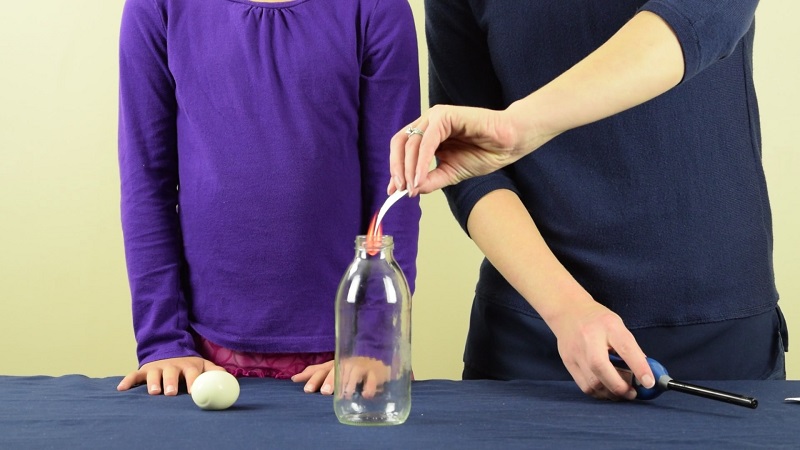
Step 4 – Once the paper is burning, carefully but quickly drop it into the glass bottle.

Step 5 – Immediately after you put the paper in the bottle, place the egg on the top of the bottle.

Step 6 – Watch as the egg begins to slowly move into the bottle. If you are lucky the egg will stay in one piece as it moves into the bottle. Or if you are like us, the egg will eventually split as it is squeezed into the mouth of the bottle. Watch the Egg in a Bottle Experiment Video Tutorial to see what happens to our egg.
Were you surprised when the egg began to move into the jar? Do you know why it did? Read the how does this experiment work section before to find the answer.
Egg in a Bottle Science Experiment Video Tutorial
How Does the Experiment Work?
Air has mass, so it has other properties like pressure and density. Air is able to push or crush objects when given the opportunity. We don’t often see air pushing or crushing objects because air molecules surrounding objects push on objects equally in all directions. In this experiment, you get to see the power of air!
Air pressure is the reason the egg moves into the bottle without us touching the egg. Let’s go over exactly what happened.
When we started the experiment, the air pressure inside the bottle was the same as the air pressure outside of the bottle because the air inside the bottle and outside the bottle was the same temperature.
After we placed the burning paper in the bottle, the air inside the bottle began to heat up and expand. A few seconds after we placed the egg on top of the bottle, the fire went out and the paper stopped burning. This caused the air inside the bottle to cool down and contract.
When the air contracts, the air pressure inside the bottle becomes less than the air pressure outside the bottle. This gives the higher air pressure outside of the bottle the opportunity to push the egg down into the bottle.
I hope you enjoyed the experiment. Here are some printable instructions:

- Hard Boiled Egg (Shell Removed)
Instructions
- Position the egg near the empty bottle. This is needed because you have to move fast once it is time to place the egg on the bottle.
- Take a strip of thick paper. Think paper is important, because you need something that won’t burn too quickly when you light it on fire during the next step. Helpful Tip: I used a piece of index card. Construction paper would also work nicely.
- Light the piece of paper and drop it into the bottle. Remember to always use safety measures when dealing with fire.
- Once the paper is burning, carefully but quickly drop it into the glass bottle.
- Immediately after you put the paper in the bottle, place the egg on the top of the bottle.
- Watch as the egg begins to slowly move into the bottle. Helpful Tip: If you are lucky the egg will stay in one piece as it moves into the bottle. Or if you are like us, the egg will eventually split as it is squeezed into the mouth of the bottle. Watch the Egg in a Bottle Experiment Video to see what happens to our egg.
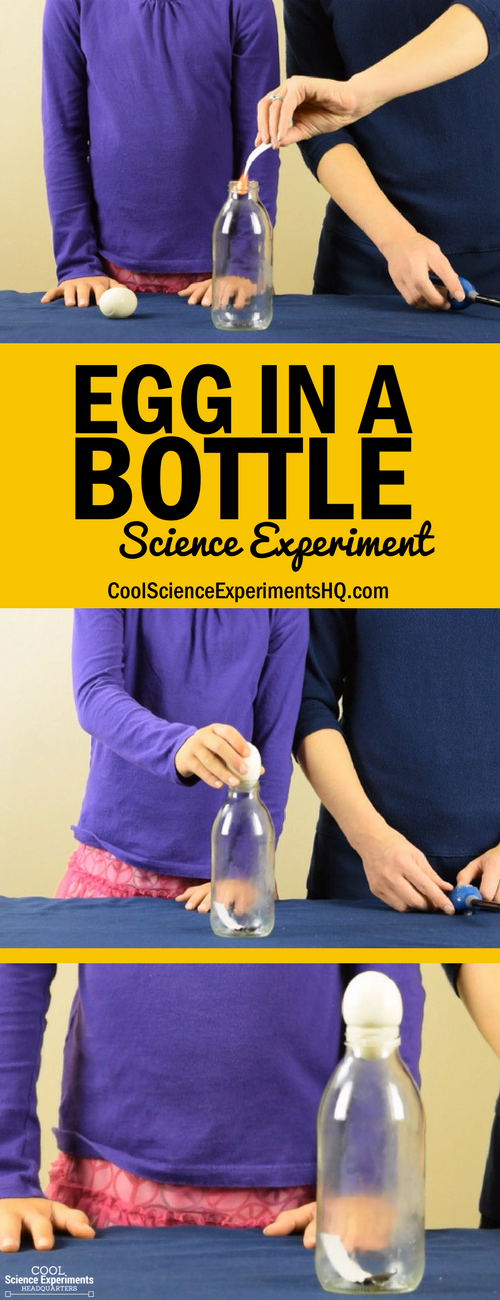
Reader Interactions
Leave a reply cancel reply.
Your email address will not be published. Required fields are marked *
Save my name, email, and website in this browser for the next time I comment.

- Privacy Policy
- Disclosure Policy
Copyright © 2024 · Cool Science Experiments HQ

Egg in a Bottle – Air Pressure Experiment
- April 21, 2021
- 10 Minute Science , 7-9 Year Olds , Physics
Science is amazing as it does wonders in our real life and around the world.
Today, Let’s explore “Egg in a Bottle”, which proves using simple science concepts anyone can put an egg into a bottle without touching it.
Yes, the egg can move into a bottle without any external help but with the help of science.
Objectives in this Science Activity
Using this experiment, children can learn,
1) Relation between Temperature and Pressure
2) Impact of air pressure on objects
3) Impact of air pressure in our daily activities
4) Properties of air
Amazed! Yes, though the experiment is quick and simple, it carries a lot of scientific information to inspire young scientists.
Egg in a Bottle – Experiment
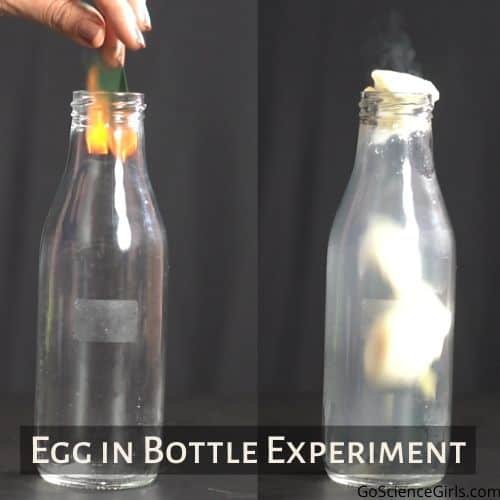
Supplies required
1) One glass container or jar. Make sure the opening of the glass jar is smaller than the size of a boiled egg because to fit the egg perfectly instead of slipping into the jar easily. Milk and Juice bottles work well for this purpose.
2) A small piece of Paper
3) Fire source i.e. a candle or lighter or a matchbox
4) One or two boiled eggs
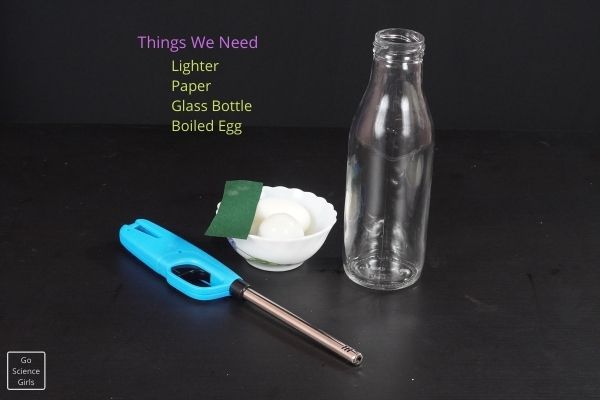
Preparations
Just before the experiment, pick fresh and raw eggs and boil them until they turn hard. Probably, this step takes 7-10 minutes.
Once boiled, peel off the outer shell part of the boiled egg and wash it under tap water to remove any hard remnants attached to the egg. Then, keep it aside on the experiment table.
Simple Step by Step Instructions
Step-1: Place a clean and transparent glass jar on the experiment table.
And then pick a piece of paper and burn it using a lighter. Please make sure the paper is folded into a strip such that it is easy for you to drop it into the jar bottle.
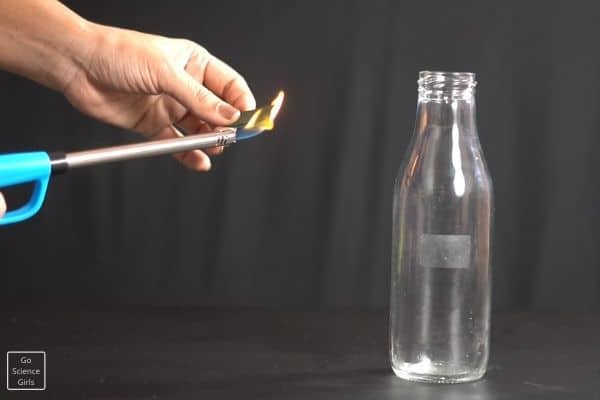
Step-2: When the paper catches fire, immediately drop it into the glass jar placed on the work table. You must drop the burning paper into the jar before the fire goes off.

Step-3: Now, Place the hard-boiled egg on top of the glass jar opening perfectly. Then observe the results.
Results: You will observe the egg slowly moving into the bottle. At times, the egg will go into the glass bottle as it is without any breakages, but sometimes it may spill while squeezing into the bottle.
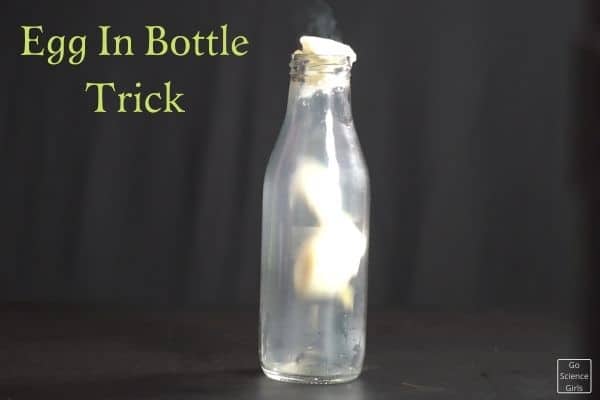
Note: If your egg fails or feeling difficult to slip down into the bottle, then you can apply vegetable oil around the neck of the bottle. Greasing oil helps the egg to move into the bottle easily.
Are you surprised watching an egg going into the bottle without any help from external forces? Do you want to learn that magical science trick? Then, let us discuss how this simple science activity worked out very well.
The Science Concepts behind The Egg in a Bottle Experiment
Air is a matter of substance, and hence it contains weight and other assets like density and pressure.
Generally, the air surrounding us or objects does not show any pressure because it surrounds with equal pressure.
But when there is additional pressure in the air, it starts showing its pressure through moving objects by push and pull trials.
In this science activity, we will observe that air shows its pressure when the opportunity is given.
Egg moving into the bottle without touching by external sources proves that air pressure is acting upon it. Let us discuss it in detail.
Before the experiment begins, the pressure of the air surrounding and inside the jar is the same as it is equally distributed.
That means the pressure inside and outside the glass bottle is the same at the beginning of the experiment.
But when we placed the burning paper into the glass bottle, the air inside the jar starts to expand. Because air molecules expand when it gets warmed up, and this is the specific characteristic of air.
And as soon as the egg is placed upon the opening of the glass bottle, the fire goes off, and the air molecules begin to cool down.
As the air molecules cool down, they start contracting themselves by lowering the air pressure inside the glass bottle.
That means there is a difference in the air pressure existing inside and outside the glass bottle.
Because there is less air pressure inside the bottle. The egg slowly squeezes into the bottle as the outside pressure pushes it from outside.
Yes, when the air molecules inside the bottle cool down, it offers more space to welcome additional air molecules.
In this process, the outside air molecules rush into the bottle to fill the spaces. So, it keeps pressure on the egg and helps it slip down into the bottle.
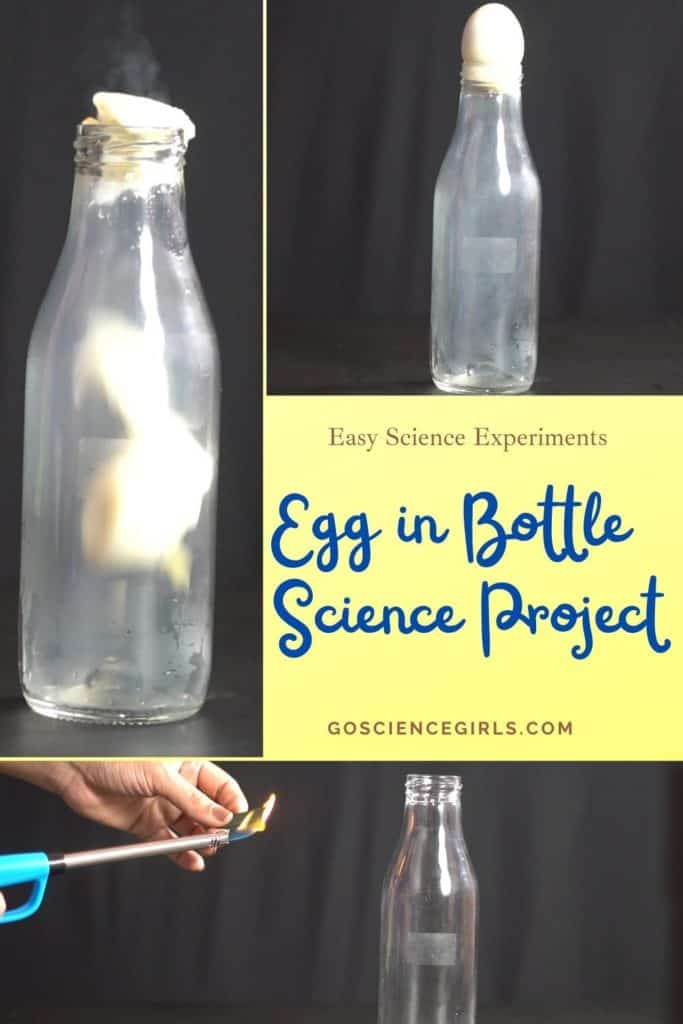
Extension Ideas
You can try out the experiment using other supplies such as boiling water and a balloon.
1) Use boiled water instead of paper inside the bottle and do the experiment
2) Try out using an inflated balloon filled with water in the place of a boiled egg.
Interesting Air Pressure Activities for Kids
Balloon in a Bottle
Crushing Can Experiment
Drip Drop Water Bottle – Science Behind Water Dispenser
Balloon in Hot and Cold Water
Tips to Teacher s
Here are the important questions a teacher can ask to make the students involved completely during the experiment. And to encourage them to participate in revealing and understanding the science behind the experiment.
1) What made an egg move into the bottle without touching it?
2) Why only eggs must be used in this science activity?
3) Are there any other possibilities to change the pressure of the air inside and outside the bottle?
4) Will the egg come out of the bottle again? If Yes, How?
5) What are the properties of air that made the egg move into the bottle?
Safety Measures
As we are dealing with fire, children need to be very careful while performing this activity. It is better to put on their safety guards even though an adult or teacher performs the activity. Adult supervision is a must when a child is performing this activity on his/her own.
Leave a Reply Cancel Reply
Your email address will not be published. Required fields are marked *
Name *
Email *
Add Comment *
Save my name, email, and website in this browser for the next time I comment.
Post Comment

How to Do the Egg in a Bottle Experiment
“Wow! How did you do that??” As a parent or a teacher, those are some of the best words you can hear. Well, after I love you, of course. And there’s nothing like science to get the kids intrigued and wondering how something works. That’s why we HAD to do the classic Egg in a Bottle Experiment . An egg, some fire, and you’ve got a really cool bottle trick on your hands! And some fascinated kids ready to learn.
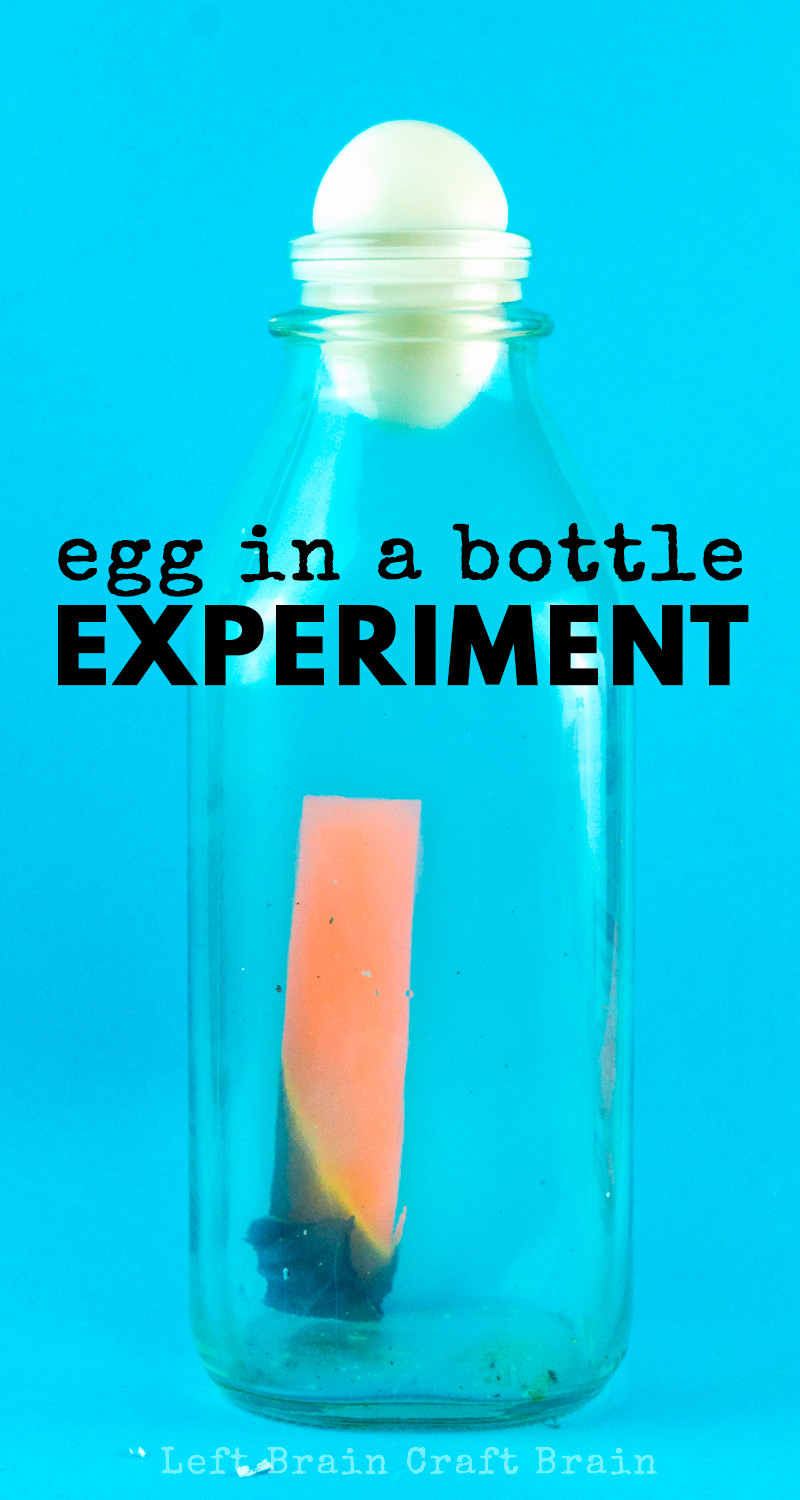
Egg in a Bottle Experiment Supplies Needed
- Hard-boiled egg, peeled (be sure to have a few because you’ll want to see this again!)
- 1-quart glass milk bottle or another glass bottle with a mouth smaller than the egg
- Matches or lighter
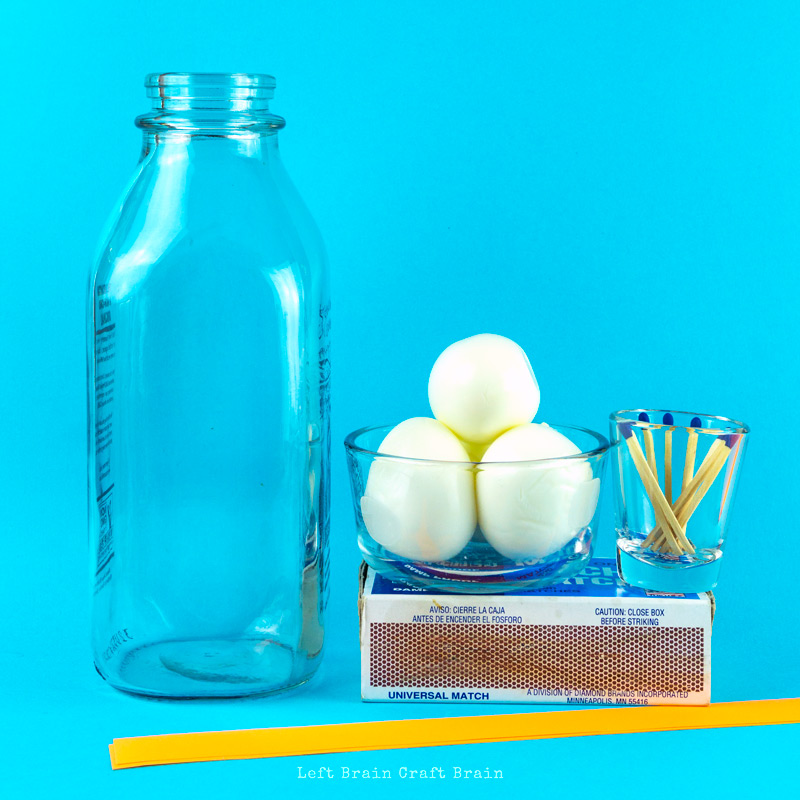
SAFETY FIRST!
This egg in a bottle trick is best done as a demonstration by adults. Children should never use matches or a lighter. Have the adult complete the part of this experiment that deals with lighting the matches and burning the paper. Always keep matches and lighters out of the reach of children. Also, keep a fire extinguisher nearby in case of emergency.
- Cut a strip of paper 6-8″ long and 3/4″ wide. The paper should be narrow enough to easily fit in the bottle and long enough that it ends below the top of the bottle when placed fully inside.
- Get your eggs ready, peeled, and nearby.
- Light the piece of paper and drop it into the bottle.
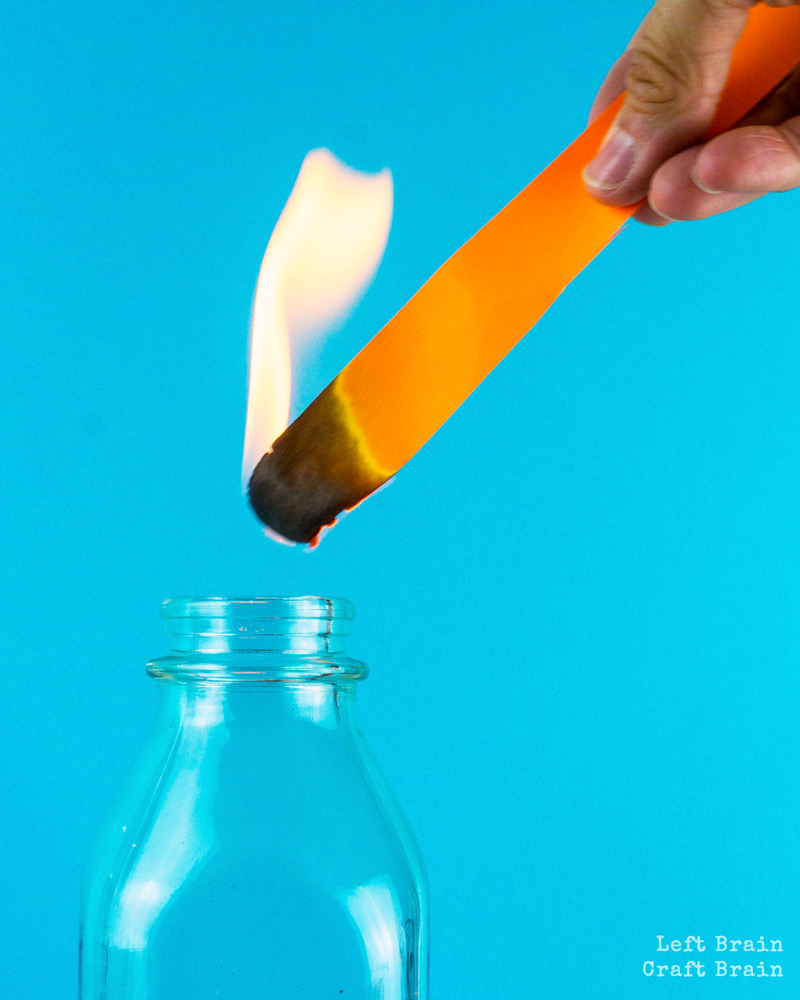
- Quickly place the hard-boiled egg on top of the mouth of the bottle.
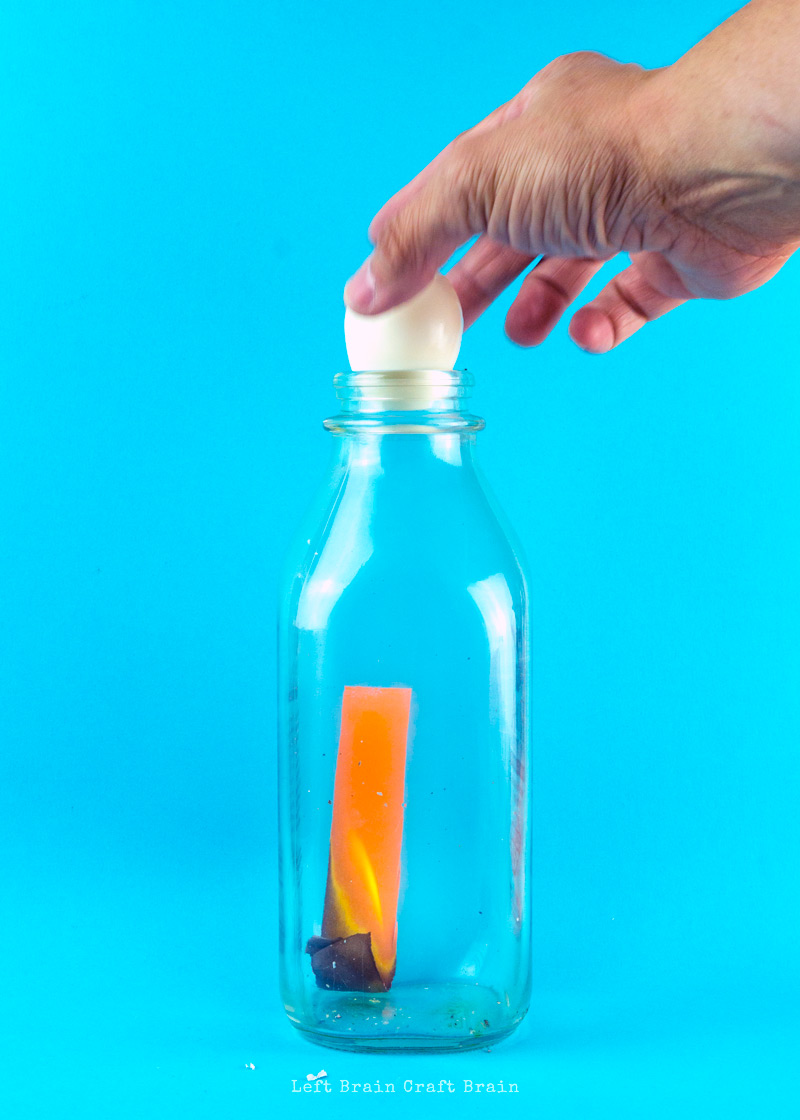
- Watch it pop inside the bottle!
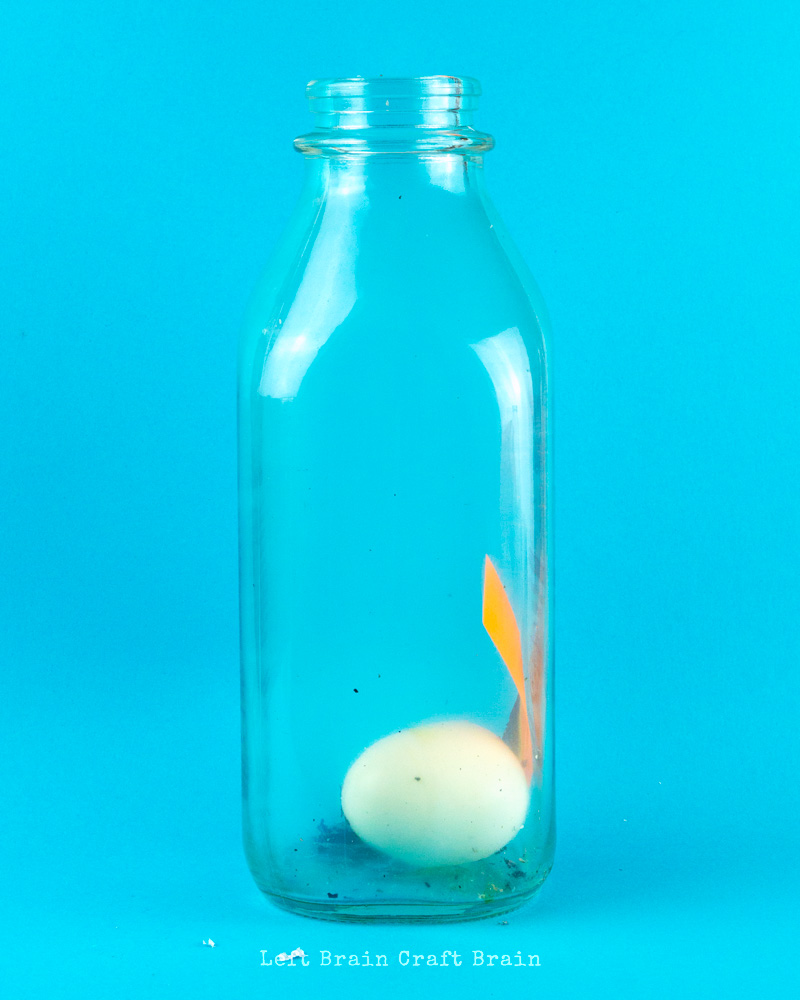
Let’s watch the experiment in action in this video…
How Did the Egg Get Sucked Into the Bottle?
This is a classic science experiment that demonstrates the power of pressure. It looks like the egg is getting sucked into the bottle. But, as my 9th-grade science teacher Mrs. Grimm drilled into our heads, there’s actually no such thing as suction. It’s just high pressure winning over low pressure. And air pressure follows something called the Ideal Gas Law.
Pressure * Volume = number of moles * R (gas constant) * Temperature
This is a cool way of remembering that when the temperature goes up, the pressure goes up, too in a fixed environment like a milk bottle. And vice versa.
So what’s happening in the experiment? When you start, the air pressure inside the bottle and the air pressure outside the bottle are equal, and the egg can’t move. But, as the paper burns inside the bottle, the temperature goes up, causing the pressure to go up. After you place the egg on the bottle top, it seals up the bottle a bit, but still allows the high pressure to force the air out of the bottle. This is why you may get to see the egg do a little jiggle on top. But, when all the air is forced out of the bottle, the burning paper runs out of oxygen and can’t burn anymore. So the flame goes out. And as you can guess, when the flame goes out, the bottle cooled and the air temperature goes down. And, so does the pressure. Suddenly, the pressure on the outside of the bottle is higher than the pressure on the inside of the bottle. And POP! In goes the egg. Because high pressure won over low pressure and air pushed the egg into the bottle.
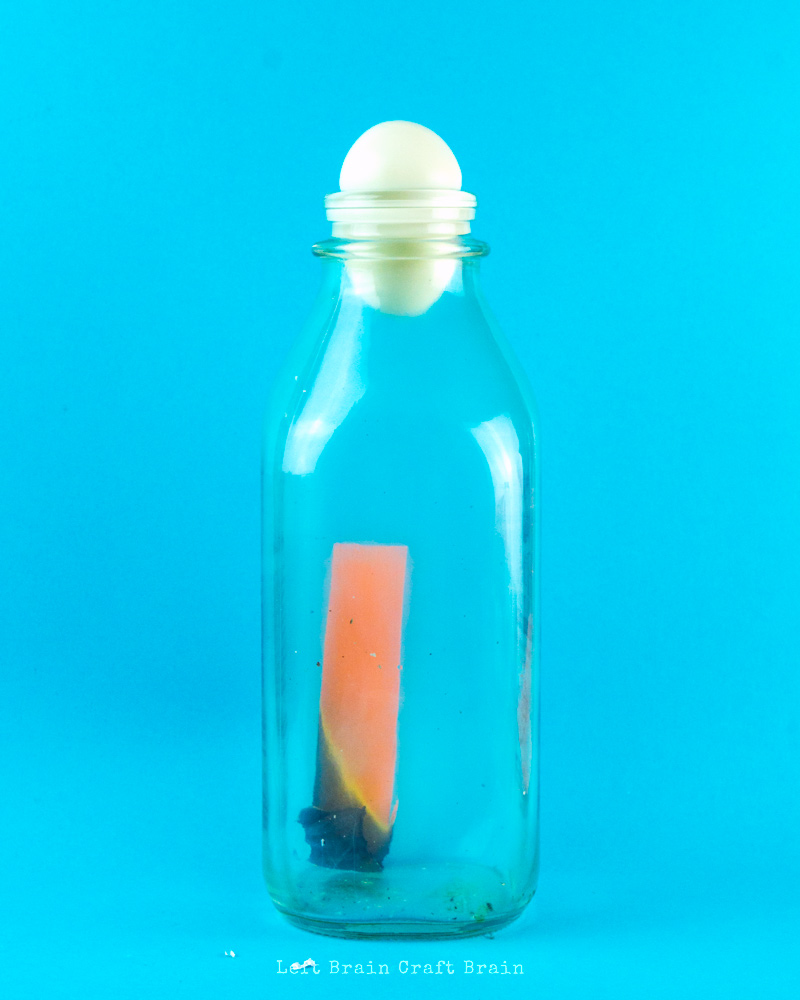
How to Remove the Egg from the Bottle
Here’s your challenge after the experiment. How do you get the egg out of the bottle? It’s a great time for experimenting! You just have to figure out how to make high pressure win over low pressure again. Basically, get the pressure in the bottle high enough that it can push the egg out. Good luck. I tried blowing in there with a straw-like I heard would work. No joy. But I’m guessing that’s why there are no pictures of getting eggs out of the bottle on the web… So first experiment, then grab a fork, break it up, and pop the bottle in the dishwasher instead…

More Science Fun for Kids
Explore the entire house with this fun At-Home Science Scavenger Hunt .
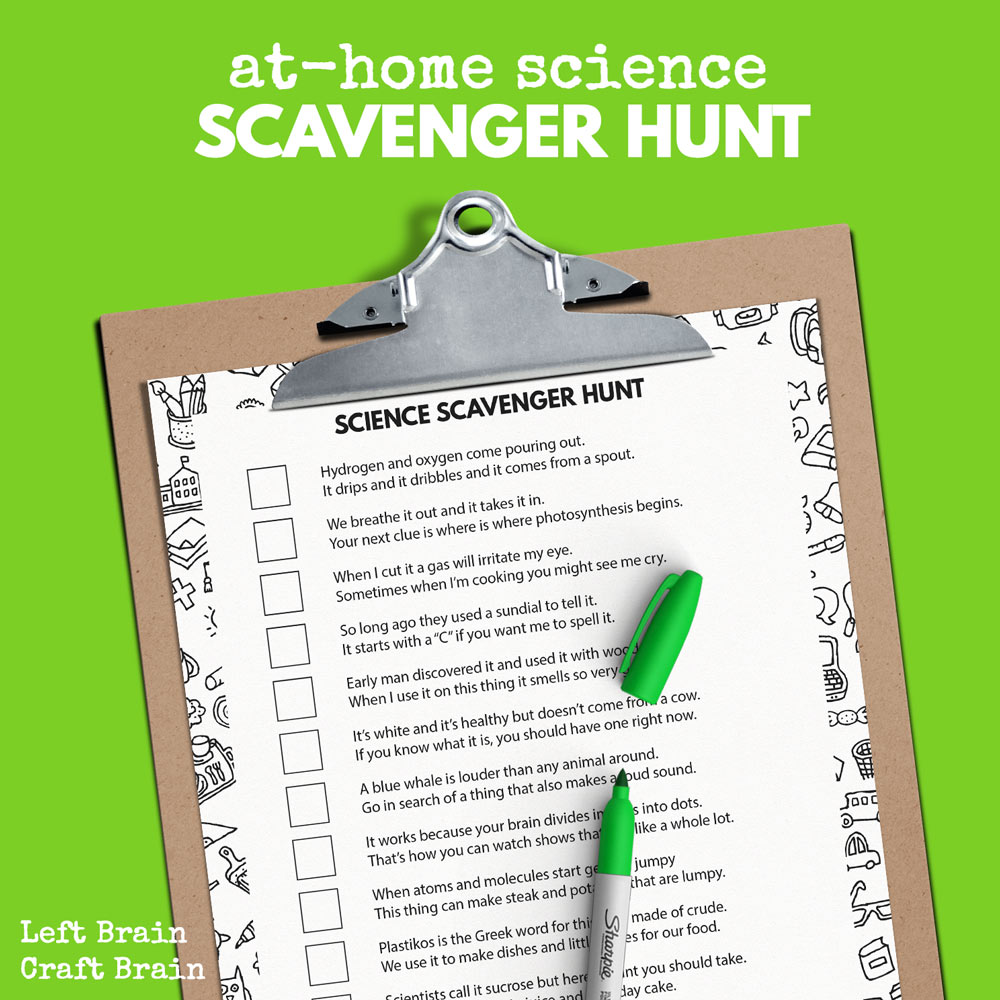
Or check out this mega list of 25+ Easy and Awesome Science Projects for Kids!
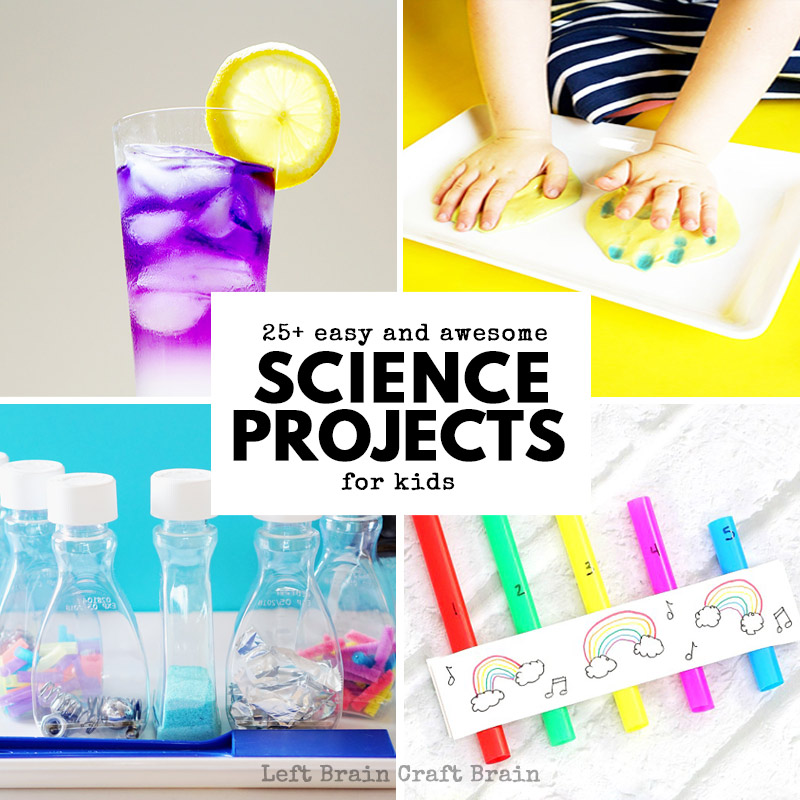
Love Kitchen Science? You'll love STEAM Kids in the Kitchen!
Looking for some more STEAM inspiration that use can use right now? Instant gratification style? Check out STEAM Kids in the Kitchen: Hands-on Science, Technology, Engineering, Art, & Math Hands-On Recipes and Activities for Kids ebook ! It’s packed full of 70+ Bring STEAM learning fun into the kitchen with these hands-on activities and recipes. Learn what makes bread rise, colors change, and how to make an epic pudding model of the Earth.
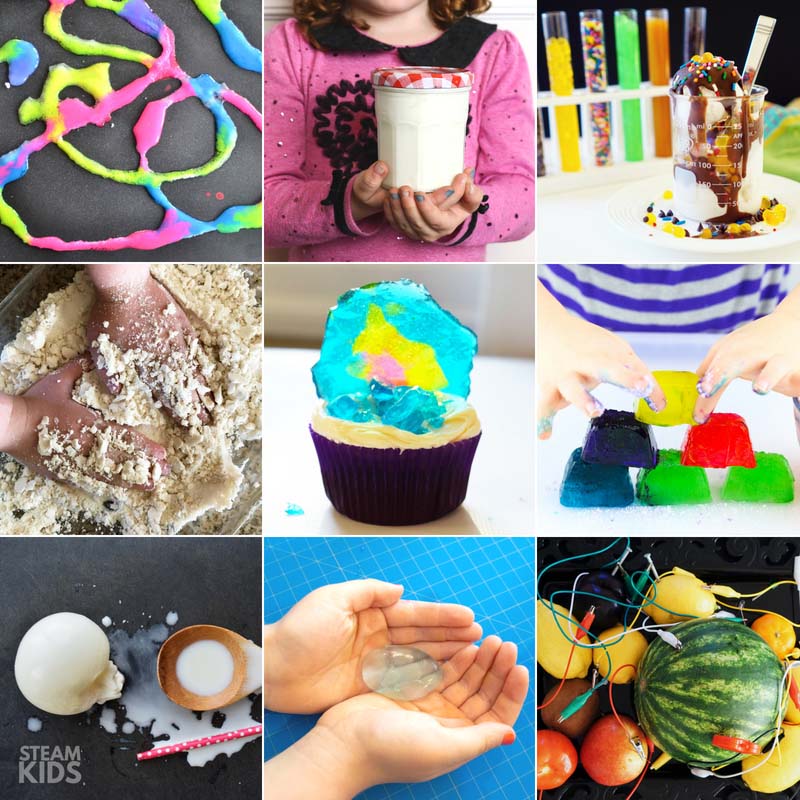
15 thoughts on “How to Do the Egg in a Bottle Experiment”
Pingback: How to Do the Egg in a Bottle Experiment • Little Genius International Kindergarten and Educational Center
Pingback: 25 6th Grade Science Projects That Will Wow Your Students – Education Discussion
Pingback: Genius Egg Experiments and STEM Projects For All Young Scientists
Pingback: 45 Best Sixth Grade Science Experiments, Projects, and Activities | atmhaber.com
Pingback: 45 6th Grade Science Projects That Will Wow Your Students - US Clock News
Pingback: 45 Best Sixth Grade Science Experiments, Projects, and Activities – E-Capitals
Pingback: 45 Best Sixth Grade Science Experiments, Projects, and Activities – I-Capitals
Pingback: 45 Best Sixth Grade Science Experiments, Projects, and Activities – Usae
Pingback: 45 Best Sixth Grade Science Experiments, Projects, and Activities - YoursBulletin
Pingback: 60 Easy Science Experiments Using Materials You Already Have On Hand | atmhaber.com
Pingback: 60 Easy Science Experiments Using Materials You Already Have On Hand - US Clock News
Pingback: 60 Easy Science Experiments Using Materials You Already Have On Hand – E-Capitals
Pingback: 60 Easy Science Experiments Using Materials You Already Have On Hand – I-Capitals
Pingback: 60 Easy Science Experiments Using Materials You Already Have On Hand - Edulogg
Pingback: 60 Easy Science Experiments Using Materials You Already Have On Hand - Country Highlights
Comments are closed.
Get a FREE! rainbow-inspired STEAM activity ebook filled with hands-on projects, printables, and recipes.
Simply fill out the form below to have this 48-page resource emailed to you! It’s a $25 value!


- Science Notes Posts
- Contact Science Notes
- Todd Helmenstine Biography
- Anne Helmenstine Biography
- Free Printable Periodic Tables (PDF and PNG)
- Periodic Table Wallpapers
- Interactive Periodic Table
- Periodic Table Posters
- Science Experiments for Kids
- How to Grow Crystals
- Chemistry Projects
- Fire and Flames Projects
- Holiday Science
- Chemistry Problems With Answers
- Physics Problems
- Unit Conversion Example Problems
- Chemistry Worksheets
- Biology Worksheets
- Periodic Table Worksheets
- Physical Science Worksheets
- Science Lab Worksheets
- My Amazon Books
Egg in a Bottle Experiment – Two Easy Methods

The Egg in a Bottle experiment is a classic science project that demonstrates the principles of air pressure in a fun and visually appealing way. Here are two different methods for performing this project, each highlighting how changing temperature in turn changes air pressure and forces a hard-boiled egg into a bottle.
Egg in a Bottle Experiment Materials
- Glass bottle with a neck slightly narrower than the egg’s diameter
- Peeled hard-boiled egg
- Matches or lighter
- Small piece of paper
Finding the right size of bottle is a challenge. Remember there are different sizes of eggs available for sale. A sturdy plastic bottle is an option instead of glass, but sometimes the temperature and pressure change deforms the bottle.
Egg in a Bottle Using a Burning Piece of Paper – Method #1
- Preparation: Peel the hard-boiled egg.
- Ignite the Paper: Light a small piece of paper using matches or a lighter. Just using a wooden match works too, but a piece of paper typically burns longer and changes the temperature inside the bottle more.
- Place the Paper in the Bottle: Quickly drop the burning paper into the bottle.
- Position the Egg: Immediately place the peeled egg on the neck of the bottle. If you like, wet the egg with water so it is a bit slippery. Sometimes this helps a larger egg fit through a smaller hole.
- Observation: After the flame goes out, the temperature inside the bottle cools and the egg slides into the bottle. Note: the egg does not enter the bottle because fire consumes oxygen! Oxygen merely rearranges into other compounds.
Explanation
When you drop the burning paper into the bottle, it heats the air inside. Heat gives molecules kinetic energy so they move more rapidly and have an increased number of collisions with the wall of the bottle. In other words, heat increases the air pressure inside the bottle . When you place the egg on the bottle, it seals it. Fresh air does not enter the bottle, so the flame consumes the oxygen and then goes out. As the air cools down, it contracts, creating a lower pressure inside the bottle compared to the outside air. The higher external air pressure pushes the egg into the bottle.
Egg in a Bottle Using Hot and Cold Water – Method #2
- Heat the Bottle: Place the bottle in hot water, which heats the air inside. (Do not submerge the bottle and fill it with water.)
- Position the Egg: After a few minutes, remove the bottle from the hot water and quickly place the peeled egg on the neck of the bottle. (If you like, place the egg on the bottle and then heat it. It makes no difference.)
- Cool the Bottle: Immerse the bottom of the bottle in cold water.
- Observation: The air inside cools and contracts. The outside air has a higher pressure than the air inside the bottle, pushing the egg through the bottle opening.
Heating the bottle with hot water expands the air inside the bottle. Some of it escapes the bottle. The egg seals the bottle. When you place the bottle in cold water, the air inside cools down and contracts, creating a lower pressure inside the bottle. The higher external air pressure pushes the egg into the bottle.
How to Get the Egg Out of the Bottle
There are ways of getting the egg back out of the bottle without breaking it up. Here are three methods:
Method 1: Reversing the Pressure
- Tilt the Bottle: Turn the bottle upside down so the egg is at the neck.
- Blow Air into the Bottle: Carefully create a seal around the bottle’s mouth with your lips and blow air forcefully into the bottle.
- Increase Pressure: The increased air pressure inside the bottle pushes the egg back out through the neck.
Method 2: Lubrication Method
This method works if there is only a small size difference between the egg and the bottle opening.
- Add Lubricant: Apply a thin layer of cooking oil or dish soap around the neck of the bottle and the surface of the egg to reduce friction.
- Position the Bottle: Turn the bottle upside down so the egg is at the neck.
- Gently Shake: Gently shake the bottle. The force of shaking helps slide the egg out. The lubricant makes it easier for the egg to pass through the neck of the bottle.
Method 3: Temperature Change
- Position the Egg: Tilt the bottle upside down so the egg is at the neck.
- Heat the Bottle: Once the egg is in the bottle neck, carefully change the bottle’s position so you can heat it. Submerge the bottom of the bottle in hot water and heat the air inside. As the air expands, pressure increases and pushes the egg out.
Of course, there is a chance these methods won’t work if the egg is too big. If you really need the egg removed and pressure is not working, insert a stick or wire into the bottle, break the egg, and shake out the pieces.
Relation to the Ideal Gas Law and the Combined Gas Law
The gas law that predicts the behavior of the egg in a bottle experiment is the Combined Gas Law , which is a special case of the Ideal Gas Law .
The equation for the Ideal Gas Law is PV = nRT, where:
- P is the pressure
- V is the volume
- n is the number of moles of gas
- R is the ideal gas constant
- T is the temperature
In this experiment, the burning paper or hot water increases the temperature (T) of the air inside the bottle. According to the Ideal Gas Law, if the volume (V) of the bottle remains constant, an increase in temperature results in an increase in pressure (P). When you place the egg on the bottle and the air inside cools, the temperature decreases, leading to a decrease in pressure. The external air pressure (higher P) then pushes the egg into the bottle to equalize the pressure difference.
For the most part, the number of moles of air, volume of air (volume of the jar), and ideal gas constant remain the same throughout the project. This makes using the Combined Gas Law possible. The Combined Gas Law is a rearrangement of the Ideal Gas Law that combines Boyle’s Law, Charles’s Law, and Gay-Lussac’s Law. The Combined Gas Law is given by:
P 1 V 1 /T 1 = P 2 V 2 /T 2
- P is the pressure of the gas
- V is the volume of the gas
- T is the temperature of the gas (in Kelvin)
- Subscripts 1 and 2 refer to the initial and final states of the gas, respectively.
So, if volume remains the same, the equation only balances out when temperature and pressure both increase or both decrease.
Method 1: Using a Burning Piece of Paper
- The burning paper heats the air inside the bottle, increase the temperature (T 1 ).
- As the temperature increases, the pressure (P 1 ) inside the bottle also increases.
- Some of the air escapes the bottle because of the increased pressure. But, it’s not enough to affect the outcome.
- The flame consumes the oxygen and the fire goes out, decreasing the temperature (T 2 ) to decrease.
- As the temperature decreases, the pressure (P 2 ) inside the bottle decreases. A common misconception is that the pressure decreases because the flame consumes oxygen, forming a partial vacuum. This is incorrect because no oxygen is lost. Instead, combustion forms carbon dioxide and water using carbon and hydrogen from the match or paper. The number and type of atoms inside the bottle remains the same.
- The volume of the bottle (V) remains constant, so the decrease in pressure creates a partial vacuum inside the bottle.
- The lower pressure inside the bottle (P 2 ) compared to the atmospheric pressure outside causes the higher external pressure to push the egg into the bottle to equalize the pressure difference.
Method 2: Using Hot and Cold Water
- Heating the bottle in hot water increases the temperature (T 1 ) of the air inside the bottle.
- The increased temperature causes the air to expand, and some air escapes the bottle, slightly increasing the volume temporarily.
- Placing the bottle in cold water cools the air inside, decreasing the temperature (T 2 ).
- As the temperature decreases, the pressure (P 2 ) inside the bottle decreases.
- The volume of the bottle (V) is effectively constant after the initial escape of some air, so the decrease in pressure creates a partial vacuum inside the bottle.
- Castka, Joseph F.; Metcalfe, H. Clark; Davis, Raymond E.; Williams, John E. (2002). Modern Chemistry . Holt, Rinehart and Winston. ISBN 978-0-03-056537-3.
- Clausius, R. (1857). “Ueber die Art der Bewegung, welche wir Wärme nennen”. Annalen der Physik und Chemie (in German). 176 (3): 353–79. doi: 10.1002/andp.18571760302
- Raff, Lionel M. (2001) Principles of Physical Chemistry (1st ed.). Pearson College Div. ISBN: 978-0130278050.
Related Posts

Reading & Math for K-5
- Kindergarten
- Learning numbers
- Comparing numbers
- Place Value
- Roman numerals
- Subtraction
- Multiplication
- Order of operations
- Drills & practice
- Measurement
- Factoring & prime factors
- Proportions
- Shape & geometry
- Data & graphing
- Word problems
- Children's stories
- Leveled stories
- Sight words
- Sentences & passages
- Context clues
- Cause & effect
- Compare & contrast
- Fact vs. fiction
- Fact vs. opinion
- Main idea & details
- Story elements
- Conclusions & inferences
- Sounds & phonics
- Words & vocabulary
- Reading comprehension
- Early writing
- Numbers & counting
- Simple math
- Social skills
- Other activities
- Dolch sight words
- Fry sight words
- Multiple meaning words
- Prefixes & suffixes
- Vocabulary cards
- Other parts of speech
- Punctuation
- Capitalization
- Narrative writing
- Opinion writing
- Informative writing
- Cursive alphabet
- Cursive letters
- Cursive letter joins
- Cursive words
- Cursive sentences
- Cursive passages
- Grammar & Writing
Breadcrumbs
Egg in a Bottle Science Experiment
The experiment involves placing a hard-boiled egg into a glass bottle without using any physical force or breaking the egg.
Materials you will need
A glass bottle with a narrow neck (such as a milk bottle)
A hard-boiled egg
Matches or a strip of paper
Vinegar (optional)
A lighter (optional)
Methodology
- Begin by hard-boiling an egg and allowing it to cool down completely. Make sure the egg is hard-boiled, as a raw egg could make a mess if it breaks inside the bottle.
- Take the glass bottle and remove any labels or obstructions from the opening. Make sure the bottle is clean and dry.
- If you want to remove the eggshell for a better visual effect, you can soak the egg in vinegar for a day or two. The vinegar will dissolve the shell, leaving the egg covered by a thin membrane. This step is optional but can enhance the experiment.
- Place the peeled hard-boiled egg near the opening of the bottle to ensure that it will fit inside.
- Light a match or a strip of paper and carefully drop it into the bottle. You want to create smoke inside the bottle. Be cautious and make sure not to burn yourself or any surrounding objects. We recommend this is performed by the parent.
- Immediately place the egg on the mouth of the bottle, making sure it covers the entire opening. Take care not to touch the sides of the bottle with the egg.
- Observe what happens. As the smoke inside the bottle cools down, it contracts, creating a partial vacuum. This reduced air pressure inside the bottle will cause the egg to be pushed inside to fill the void. This may take a bit of patience for this to happen, but be careful not to force the egg into the bottle manually.
- Once the egg is inside the bottle, you can tilt the bottle to allow the egg to roll out.
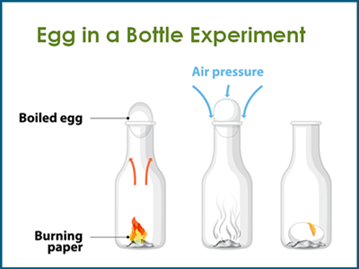
Note: If you don't want to use fire or matches, an alternative method involves heating the air inside the bottle by placing it in a bowl of hot water or using a hairdryer to blow hot air into the bottle. This heating process will create a similar pressure difference, drawing the egg into the bottle.
Remember to exercise caution during the experiment, especially when handling fire or hot objects.
This content is available to members only.
Join K5 to save time, skip ads and access more content. Learn More
Science Fun

Find A Hard Boiled Egg Force And Motion Science Experiment
In this fun and easy force and motion science experiment for kids, we’re going to try and find a hard boiled egg.
- Two raw eggs
- One hard boiled eggs
Instructions:
- Spin each of the eggs and observe what happens.
- Two of the eggs will wobble but one will spin. The egg that spins is the hardboiled egg.
- Now lightly touch each egg as it spins.
- The hardboiled egg will stop spinning but the raw eggs will continue to move.
EXPLORE AWESOME SCIENCE EXPERIMENT VIDEOS!
How it Works:
Inertia will cause the loose yolks and whites of the raw eggs to continue trying to move.
EXPLORE TONS OF FUN AND EASY SCIENCE EXPERIMENTS!
SUBSCRIBE AND NEVER MISS A NEW SCIENCE FUN VIDEO!
previous experiment
Next experiment.

IMAGES
COMMENTS
Watch as the egg begins to slowly move into the bottle. Helpful Tip: If you are lucky the egg will stay in one piece as it moves into the bottle. Or if you are like us, the egg will eventually split as it is squeezed into the mouth of the bottle. Watch the Egg in a Bottle Experiment Video to see what happens to our egg.
First, the science behind a hard-boiled egg: Egg whites are made of water and proteins. Proteins are made of long chains of amino acids, but in an egg, the chains are clumped tightly together in individual spheres. (These are called "globular proteins.") When the egg is heated, the proteins and water molecules begin to move faster.
Jul 4, 2020 · Science Experiment with hard boiled eggs Experimenting with hardboiled egg sounds silly but there is a bit of interesting and simple science involved in this experiment. Do it with your kid and know the interesting results of this experiment.
Apr 21, 2021 · Just before the experiment, pick fresh and raw eggs and boil them until they turn hard. Probably, this step takes 7-10 minutes. Once boiled, peel off the outer shell part of the boiled egg and wash it under tap water to remove any hard remnants attached to the egg. Then, keep it aside on the experiment table. Simple Step by Step Instructions
Egg in a Bottle Experiment Supplies Needed. Hard-boiled egg, peeled (be sure to have a few because you’ll want to see this again!) 1-quart glass milk bottle or another glass bottle with a mouth smaller than the egg; Matches or lighter; Paper; Straw
Jul 17, 2024 · The Egg in a Bottle experiment is a classic science project that demonstrates the principles of air pressure in a fun and visually appealing way. Here are two different methods for performing this project, each highlighting how changing temperature in turn changes air pressure and forces a hard-boiled egg into a bottle.
For this experiment, we are going to put a hard boiled egg into the bottle. First, you need a hard boiled egg. Let it cool and carefully remove the shell. Be sure not to damage the egg, as this will keep the experiment from working properly. If you accidentally tear your hard boiled egg, put it in a bowl and chop it with a little mayonnaise or ...
Nov 9, 2013 · For this experiment, you are demonstrating how air pressure works by sucking a hard-boiled egg into a bottle. Here’s what you need for the egg in a bottle experiment: A clear, empty container with a narrow top
A hard-boiled egg. Matches or a strip of paper. Vinegar (optional) A lighter (optional) Methodology. Begin by hard-boiling an egg and allowing it to cool down completely. Make sure the egg is hard-boiled, as a raw egg could make a mess if it breaks inside the bottle. Take the glass bottle and remove any labels or obstructions from the opening.
In this fun and easy force and motion science experiment for kids, we're going to try and find a hard boiled egg. Materials: Two raw eggs One hard boiled eggs Instructions: Spin each of the eggs and observe what happens. Two of the eggs will wobble but one will spin. The egg that spins is the hardboiled egg. Now lightly touch each egg as it spins. The hardboiled egg will stop spinning but the ...